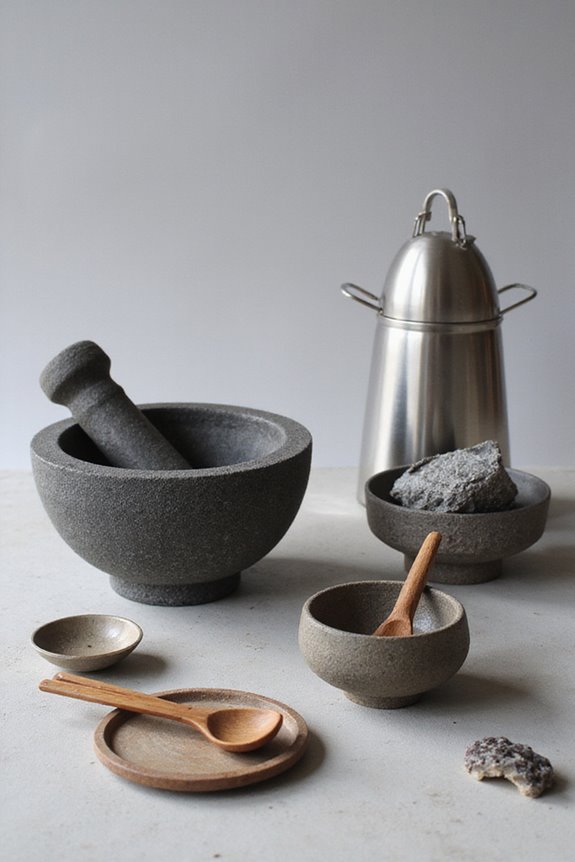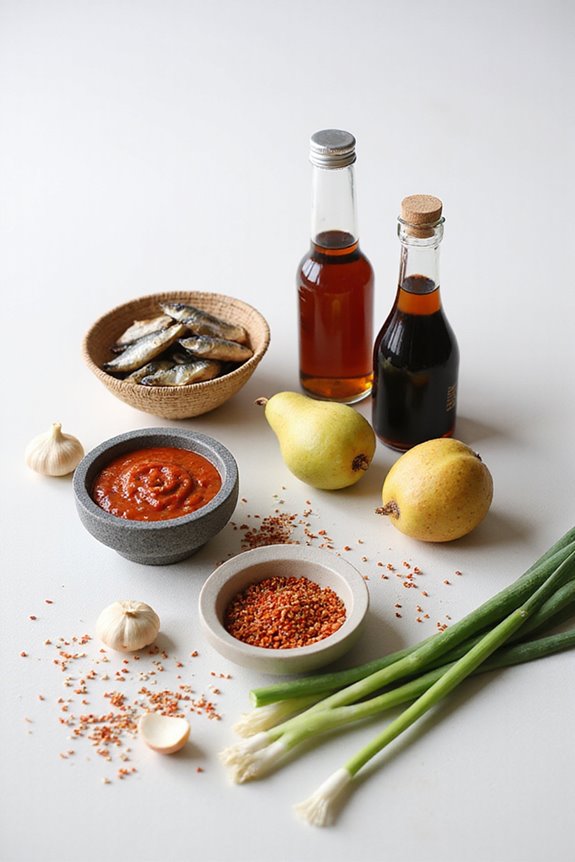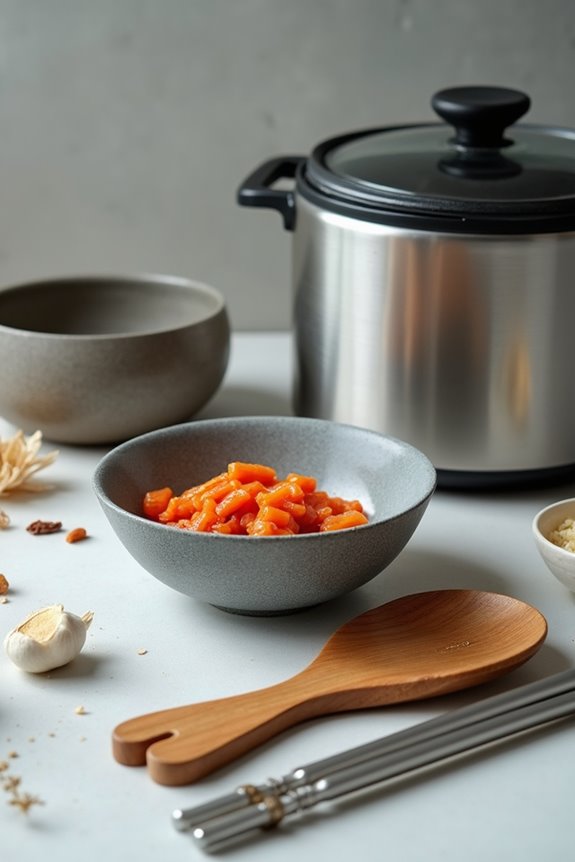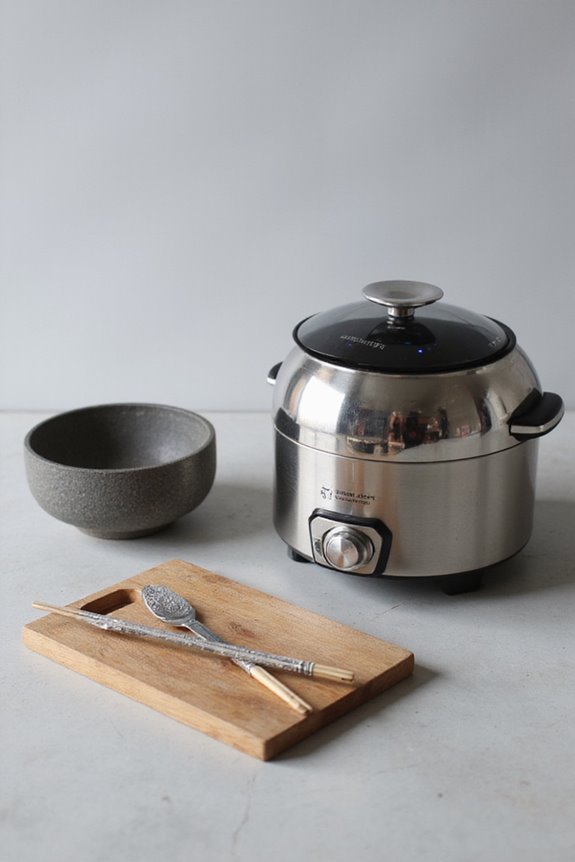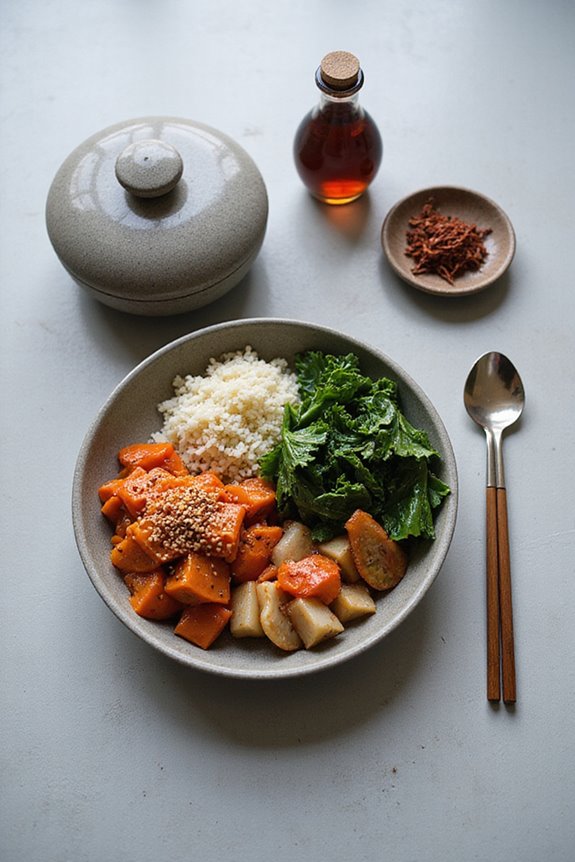Korean cuisine employs several food preparation methods that enhance its unique flavors and textures. We use boiling and simmering to extract natural tastes, such as in the boiling of pork belly for bossam. Fermentation is crucial for creating seasonings like soy sauce and doenjang. Grilling is fundamental for dishes like bulgogi, while roasting enhances proteins and vegetables for deeper flavors. Steaming guarantees tender dishes like gyeranjjim. Each method contributes to a rich culinary experience, and there’s much more to explore.
Key Takeaways
- Boiling and simmering are essential for extracting flavors in soups and stews, exemplified by dishes like Bossam.
- Fermentation is vital for flavor development and food preservation, producing key ingredients like soy sauce and fermented soybean paste.
- Grilling plays a central role in creating rich flavors, emphasizing marinated fatty meats and communal dining experiences.
- Roasting techniques enhance the natural flavors of meats and vegetables, focusing on moisture retention and depth of taste.
- Steaming, or “jjim,” merges gentle cooking with rich flavors, often used for dishes like gyeranjjim in stone bowls.
Boiling and Simmering
Boiling and simmering are fundamental cooking techniques in Korean cuisine that we often utilize to create richly flavored soups and stews. By employing boiling techniques, we cook ingredients in water or broth, allowing their natural flavors to emerge. When we switch to a simmer, the gentle heat enhances simmering benefits, letting flavors meld together harmoniously. For instance, in dishes like Bossam, we boil pork belly along with aromatics like garlic and scallions, producing tender meat. The slow simmering process guarantees that all ingredients develop a deeply layered taste, while also nurturing the dish’s nutritional value. Ultimately, these methods not only deliver comforting textures but also embody the balance present in Korean culinary traditions.
Fermentation
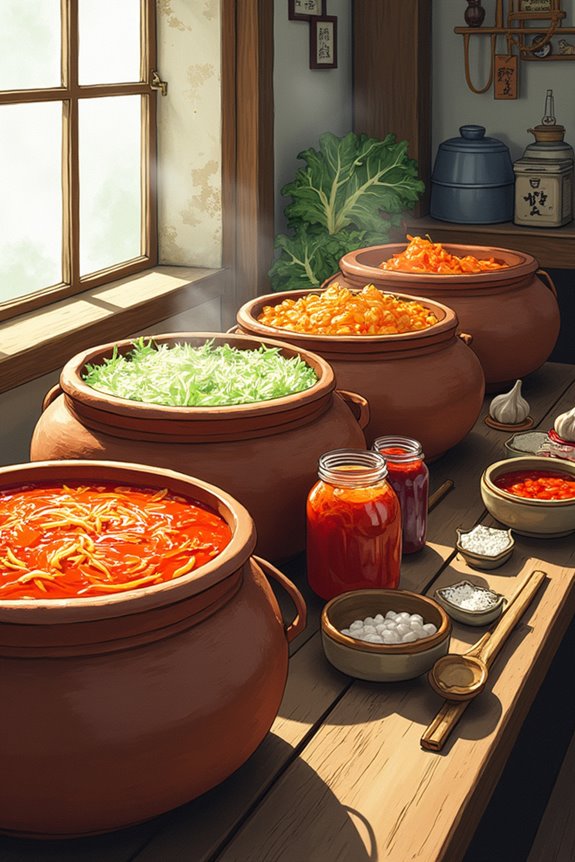
In Korean cuisine, fermentation plays a foundational role in creating distinctive flavors and preserving food. We utilize traditional techniques that harness local microbial ecosystems to enhance flavor development and nutritional enhancement. Key fermentation vessels, such as *onggi* and *hangari*, allow for controlled airflow and ideal environmental factors, promoting beneficial microbial activity. This process often produces well-known products, including soy sauce (*ganjang*) and fermented soybean paste (*doenjang*), which serve as essential seasonings in numerous dishes. Fermented foods provide significant probiotic benefits, improving gut health and overall nutrition. Additionally, the cultural practices surrounding fermentation reflect its importance in daily life, linking generations through shared culinary heritage. Understanding these methods enriches our appreciation of Korean food traditions.
Grilling
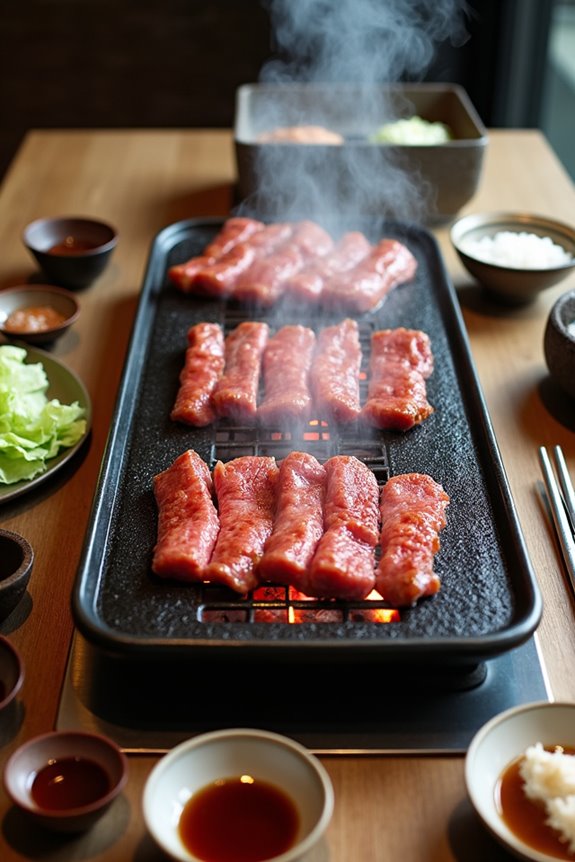
Grilling is a central aspect of Korean cuisine, allowing us to develop rich flavors and create a communal dining experience. We often start with fatty meats like pork belly, letting their natural fats season the grill. Afterward, we grill lean cuts such as bulgogi and galbi, following specific grill techniques to guarantee even cooking. We finish with marinated meats, which caramelize quickly if cooked too early. It’s crucial to separate marinated and unseasoned meats on the grill to prevent sticking. Using tongs for grilling and scissors for cutting during cooking enhances efficiency. To maintain juiciness, we avoid pressing down on the meat and only flip it after a golden-brown crust forms, assuring ideal texture and flavor absorption.
Roasting
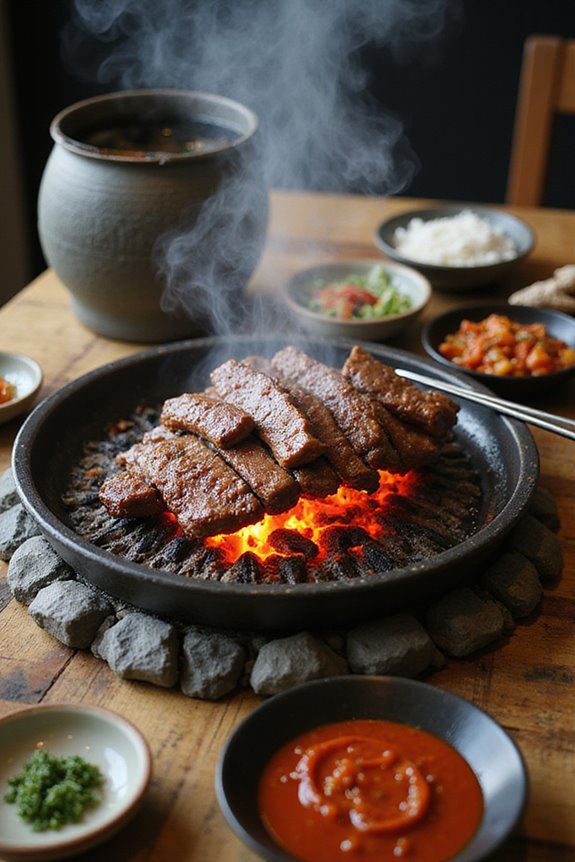
Roasting plays an essential role in Korean culinary traditions, where we enhance the natural flavors of various proteins and vegetables through specific techniques. In our kitchens, we often choose beef cuts like chuck roast, seasoned with ingredients such as salt, fresh ginger, soy sauce, and gochujang. This combination creates a rich umami profile. Additionally, we employ low and slow methods, often starting by browning the meat to seal in juices before roasting in a covered Dutch oven. Similarly, when we focus on seaweed crisping, traditional gender techniques involve roasting gim over low heat to enhance flavor and aroma. Both processes exemplify our dedication to preserving moisture and achieving depth in taste, reflecting Korean food’s unique characteristics.
Steaming
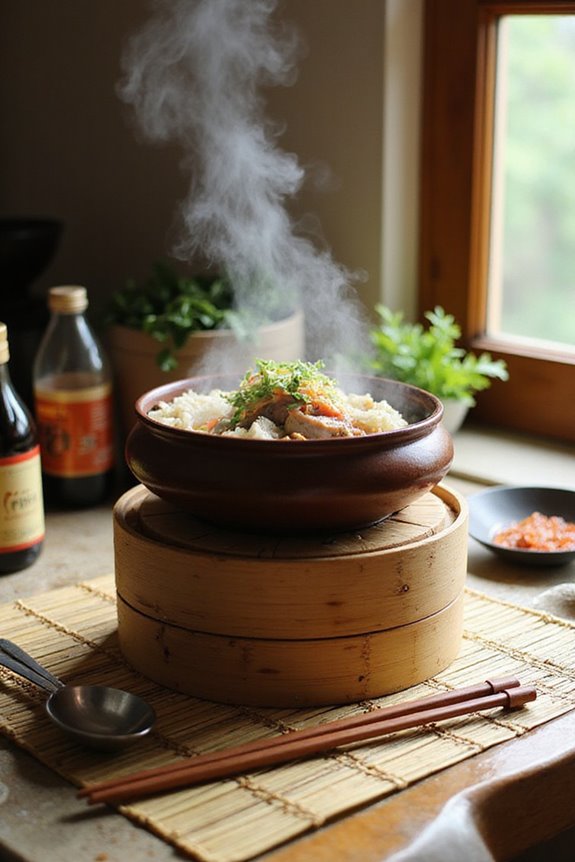
Steaming, or “jjim,” is a cornerstone of our Korean culinary practices, as it combines gentle cooking techniques with rich flavors. This method, which integrates steaming techniques with braising and boiling, enhances the tenderness of meats and vegetables, allowing them to achieve melt-in-the-mouth textures. Common jjim dishes, like gyeranjjim (steamed eggs), benefit from heat retention in traditional stone bowls, resulting in a soft, soufflé-like consistency. We always soak short or medium-grain rice to promote even cooking and the desired sticky texture. By maintaining precise boiling water levels and covering pots tightly, we trap steam effectively, preventing nutrient loss and delivering flavorful, nutrient-rich meals. Each steaming process contributes to the overall taste, making our dishes unique and satisfying.
Marination
When we consider the art of marination in Korean cuisine, it’s crucial to recognize its significant role in enhancing flavor and texture in our favorite dishes. Korean marinade variations often include low sodium soy sauce as a base, combined with sweeteners like brown sugar or honey, and aromatic ingredients such as minced garlic and ginger. These components not only impart flavor enhancement but also serve practical purposes, like tenderizing meat through fruit purees, including Korean pear. For proteins, marination times vary; beef may marinate for several hours, while seafood requires only 15 to 30 minutes to avoid over-softening. This precise timing helps us achieve ideal flavor profiles and guarantees that each bite is rich and satisfying.
Stir-Frying
Stir-frying is a fundamental cooking technique in Korean cuisine that allows us to quickly prepare a variety of dishes while preserving the natural flavors and nutritional qualities of the ingredients. This method relies on precise stir fry techniques, where high wok heating is essential for even cooking and maintaining texture. We begin by heating a well-oiled wok until it’s rippling hot, ensuring we avoid sogginess. Ingredients are uniformly cut into bite-sized pieces, enhancing fast cooking. Meats are seared first for browning, then vegetables are added for a crisp-tender finish. As the stir-fry completes, we add sauces and seasonings like soy sauce and sesame oil to elevate flavors. This process usually takes about 5-6 minutes, resulting in a balanced and satisfying dish.
Frequently Asked Questions
What Are the Best Utensils for Korean Cooking?
We can’t cook without the best kitchen tools! For our Korean dishes, let’s grab our metal chopsticks, chef’s knife, and mixing bowls. Mastering these will elevate our cooking techniques to a whole new level!
How Can I Adjust Spice Levels in Korean Dishes?
To adjust spice levels in Korean dishes, we can use spice substitutions and flavor balancing techniques. By gradually adding seasoning and incorporating dairy or acid, we’ll find a comfortable heat without losing flavor.
What Types of Rice Are Commonly Used in Korean Cuisine?
When we enjoy a kimbap picnic, we appreciate the importance of Korean rice. Its versatility shines through various cooking techniques, from steaming glutinous rice to using white rice—each choice enhances our favorite dishes.
How Do I Store Leftover Korean Dishes Properly?
When storing kimchi, we should use airtight containers to keep it fresh. For reheating bibimbap, a quick stir in a skillet with a splash of water helps restore its original texture.
What Are Traditional Korean Table Setting Practices?
When we think of traditional Korean table etiquette, we embrace an artful serving style where each bowl finds its perfect place. Respectful arrangements and mindful seating reflect our values, guiding us through shared meals with harmony.

